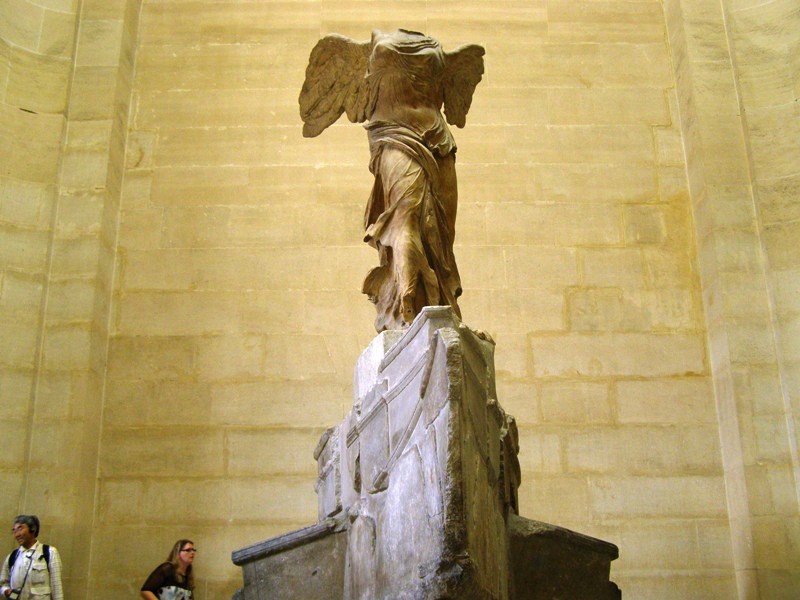There are great works of art from Ancient Greece scattered in museums around the world, serving as reminders that Greece is the cradle of Western Civilization. Works of unparalleled beauty, precious monuments of the world’s rich heritage that still mesmerize and will continue to do so in the generations to come.
Pergamon Altar
Built about 150 BC on the Acropolis — the highest point — of the ancient Greek city of Pergamon in Asia Minor, the Altar of Zeus at Pergamon, near modern-day Izmir, Turkey, is a monumental work of Greek Hellenistic art. Greek King Eumenes II built the monumental structure that is over 35 meters wide and 33 meters deep. Today it is kept at the Pergamon Museum in Berlin.
Mask of Agamemnon, King of Mycenae
The gold Mask of Agamemnon was discovered in 1876 by Heinrich Schliemann during his excavations at Mycenae in Greece. It was found covering the face of a body in a burial shaft. It is dubbed as being the face of the legendary Greek leader during the Trojan War who tradition says was buried at Mycenae and has become associated with Homer’s hero. It dates to about 1550–1500 BC; some 300 years before Agamemnon. The mask is displayed in the National Archaeological Museum in Athens.
Venus de Milo
Exhibited at the Louvre Museum, the marble piece world-renowned for its beauty and admired for its Hellenistic artistry is Aphrodite of Milos. This piece of art was likely created by Alexandros of Antioch during the late 2nd century BC. It features a nearly nude, larger-than-life (6 feet, 8 inches tall) female figure that traditionally is believed to represent Aphrodite, the goddess of love. It was unearthed on Milos island in the 19th century.
Winged Victory of Samothrace
Also displayed at the Louvre Museum, the Winged Goddess of Victory (Nike) standing on the prow of a ship overlooked the Sanctuary of the Great Gods on the island of Samothrace. According to historians it was an offer by the people of Rhodes in commemoration of a naval victory in the early second century BC. The vigorous, theatrical movement of the Hellenistic sculpture are magnificently sculpted. The monument was unearthed in 1863 on Samothrace in the northwest Aegean. It was discovered by Charles Champoiseau, French Vice-Consul to Adrianople (Edirne), Turkey.
Generally known as either the Parthenon Marbles, Parthenon Sculptures, or the Elgin Marbles, the statues that comprise the rich metope of the Parthenon, or the frieze of Parthenon. Of the 97 surviving stones of the Parthenon Frieze, 56 are at the British Museum in London, taken there in the beginning of the 19th century by Lord Elgin. Their presence there and the refusal of the museum to return then to their place of origin so they “rejoin” with the rest of the still-standing Parthenon is the cause of a row between Greece and the British Museum. The South Metopes in the British Museum show the battle between Centaurs and Lapiths at the marriage feast of Peirithoos. The remaining sculptures are displayed at the new Acropolis Museum in Athens.
The Siren Vase is one of the more well-known Ancient Greece masterpieces, depicting the sirens that try to seduce Odysseus on his long return journey to Ithaca, the legendary hero being tied to the mast to not heed to their treacherous call. It is attributed to “The Siren Painter”. It is thought to have been made somewhere in between 480 BC and 470 BC. It is part of the British Museum’s permanent collection.
The Fallen Warrior of Aphaia
The Fallen Warrior from the Temple of Aphaia at Aegina was made in 510 BC. It depicts a warrior who is badly injured but refuses to surrender. The size of the sculpture is extravagant, contributing to the awe-inspiring effect. It is on display at the Glyptothek of Munich, as it was discovered in the 20th century by the German Archaeological School on Aegina island.
Hermes and the Infant Dionysus by Praxiteles
Hermes and the Infant Dionysus, also known as the Hermes of Praxiteles, was discovered in 1877 in the ruins of the Temple of Hera, in Olympia, in Greece. Today It is displayed at the Archaeological Museum of Olympia. The statue is attributed to Praxiteles and dated to the 4th century BC, based on a remark by the 2nd century Greek traveller Pausanias, and has made a major contribution to the definition of Praxitelean style.
The Artemision Poseidon
The bronze statue that Greeks call Poseidon of Artemision since it was discovered in the sea off Cape Artemision in Evia, is considered by some archaeologists that it depicts Zeus. It is 2.09 meters tall and tradition says that it is Poseidon holding a trident. For others it is Zeus ready to throw a thunderbolt. Its maker is unknown but archaeologists place it around 460 BC, based on the style. Its is displayed at the National Archaeological Museum of Athens.
The Riace Bronze Warriors
The Riace Warriors or Riace Bronzes are two life-size Greek bronze statues of naked, bearded warriors. The statues were discovered by Stefano Mariottini in the Mediterranean Sea just off the coast of Riace Marina, Italy, on August 16, 1972. The statues are currently housed in the Museo Nazionale della Magna Grecia in the Italian city of Reggio Calabria. The statues are commonly referred to as “Statue A” and “Statue B” and were originally cast using the lost-wax technique.

Source: Top Ten Ancient Greek Masterpieces | GreekReporter.com










